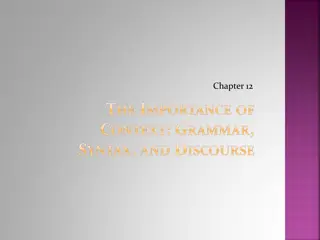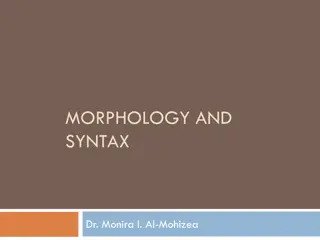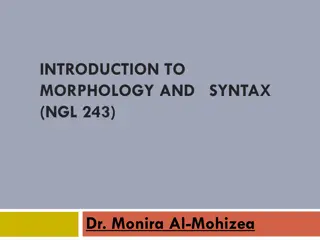Understanding Syntax and Constituents in Morphology
Explore the relationship between morphology, syntax, and constituents through visuals and examples. Learn how to identify constituents in sentences, understand ambiguous structures, and conduct tests for morphological and syntactic analysis.
Download Presentation

Please find below an Image/Link to download the presentation.
The content on the website is provided AS IS for your information and personal use only. It may not be sold, licensed, or shared on other websites without obtaining consent from the author. Download presentation by click this link. If you encounter any issues during the download, it is possible that the publisher has removed the file from their server.
E N D
Presentation Transcript
Morphology & Syntax Constituents 1
2 Mapping between syntax and semantics Simple clauses show the mapping between syntax and semantics. (clause Prototype of a transitive verb and a transitive clause Pat hit Sam. Subject Object Agent Patient event)
3 Sentences Are sentences simply strings of connected words? A black cat is on a red mat. No! phrases (heads + dependents)
4 How do we identify constituents? Constituent: a structural unit, a set of words that forms a phrase A black cat is on a red mat. a black cat is, cat is on, on a red? How do we know (and test) that a black cat , a red mat , on a red mat , and is on a red mat are constituents?
5 Ambiguous sentences Lexical ambiguity bank, Structure ambiguity Pat said that Sam cried yesterday.
6 Caution You can t tell whether a string of words is a constituent out of context. cheap textbooks The students wondered how [cheap textbooks] could be obtained. The students wondered how cheap textbooks could be.
7 Morphological test NP constituents English possessive s [a black cat] s owner The boy and the girl s uncle stayed to dinner. [The boy and the girl] s uncle The boy and [the girl] s uncle
8 Phonological test Negative contraction -n t She could not go to the party. She [could not] go to the party. She could [not go to the party]. She couldn't go to the party.
9 Syntactic tests Sentence fragment Echo question Cleft construction Preposing/postposing do so test for VP
10 Sentence fragment A string of words that can be a sentence fragment must be a constituent. A black cat is on a red mat. What is on a red mat? A black cat./ *Black cat./ *A black. Kim bought that book with her first wages. What did Kim buy? That book./ *That book with her first wages. Kim wrote that book with the blue cover. What did Kim write? That book with the blue cover.
11 Echo question In an echo question, a wh-word (what, which, who, when, why, where and how) replaces a constituent. A black cat is on a red mat. A black cat is on what? Kim bought that book with her first wages. Kim bought what with her first wages? Kim wrote that book with the blue cover. *Kim wrote what with the blue cover?
12 Cleft construction It be FOCUS clause: It is Sue that I like. A string of words in the focus position must be a constituent. Kim bought that book with her first wages. It was [that book] that Kim bought with her first wages. It was [with her first wages] that Kim bought that book. *It was that book with her first wages that Kim bought. Kim wrote that book with the blue cover. It was [that book with the blue cover] that Kim wrote.
13 Preposing/postposing Preposing: a phrase is positioned at the front of the sentence for emphasis. A phrasal constituent can be preposed. I like yellow flowers. Yellow flowers, I like. (but, red flowers, I hate.) *Flowers, I like yellow. He ran up the hill. Up the hill, he ran. Phrasal verb vs. Prepositional verb He rang up his mother. *Up his mother, he rang.
14 Preposing/postposing Postposing: a phrase is positioned at the end of the sentence due to its length. A phrasal constituent can be postposed. He put an apple in his basket. ?* He put in his basket an apple. He put a dozen of eggs, two bottles of water, four pairs of sandwiches, and six apples in his basket. He put in his basket a dozen of eggs, two bottles of water, four pairs of sandwiches, and six apples.
15 do so test for VP A VP constituent can be replaced by do so . I thought that Mel [bought that book] (with some of her inheritance). No! Kim [did so] with her first wages. I thought that Mel wrote that book with the blue cover. *No! Kim did so with the blue cover.
16 Tree diagram A cat is on a mat.
17 Tree diagram Nodes Phrasal nodes S node Lexical nodes Terminal nodes (lexical items) Branches
18 Tree diagram Tree diagrams exhibit constituency, hierarchy, category labels of nodes, and linear order. There are aspects of sentence structures that cannot easily be shown in tree diagrams.
19 Relationship Dominance A node immediately dominates the next node below it if 1) they are connected by a branch, and 2) no other node intervenes. Mother: a node that immediately dominates another node or set of nodes Daughter: a node or set of nodes that are immediately dominated by another node Sisters: set of daughters that share the same mother A node dominates the nodes below it if there is an unbroken series of branches connecting them. X c-commands Y iff the first branching node of X dominates Y, and X does not dominate Y, nor Y dominate X.
20 Relationship Precedence A node immediately precedes another node if it occurs immediately to the left of it. A node precedes another node if it occurs to the left of it, and neither node dominates the other.
21 A constituent A set of elements forms a constituent in a tree diagram if and only if there is a single node that dominates just these elements, and no other items.
22 Tree diagrams John drove his car into a tree. Many parents give chocolate and cookies to their children. Chefs from developing countries competed in a difficult contest.
23 Phrase structure rules (PS rules) S NP VP PP
24 More tree diagrams Pat said that Sam cried yesterday. Sam saw a bear with a telescope.
25 More syntactic tests Proform Ellipsis Co-ordination
26 Proform Proform (replaces a constituent) [A black cat] is on a red mat. It is on a red mat. Kim [ate hotdogs], and Sue did so, too. Mary went [to London], and Mike went there, too.
27 Ellipsis An omitted string is a constituent. Pat can [swim 20 miles per hour]. Sam can [ ], too. *Kim likes cats. Sam likes [ ], too.
28 Co-ordination Only constituents of the same syntactic category can be conjoined (e.g. NP + NP, VP + VP). Sam ate [a duck] and [a rabbit]. Pat [cooked] and [cleaned the house]. *John wrote [down the address] and [down the phone number]. Co-ordinating conjunctions When two constituents of the same category are conjoined, they form one larger constituent of the same category.
29 Shared constituent co-ordination Right node raising John likes but Mary hates [apples]. *John rang but Mary picked [up the teacher]. The shared string is a constituent in each of the conjuncts.
30 Bar notation NP N N I admired [the director s treatment of the issues]. Sue likes [cats].
31 Bar notation Proform one for N This [black cat] is smarter than that [one].
32 Complement and adjunct N + Complement N + Adjunct Spec + N N N NP A student of physics A student with long hair A student of physics with long hair *A student with long hair of physics
33 Complement and adjunct The investigation of the case after lunch Mom s favorite daughter The handsome prince of Egypt N + XP N + XP Spec + N N N NP
34 AP She is [rather fond of fruit]. A + XP A + XP Spec + A A A AP
35 PP She ran [right across the bridge]. P + XP P + XP Spec + P P P PP
36 VP They [all read the letter]. V + XP V + XP Spec + V V V VP
37 X-bar theory Phrase structures are generated by X + YP (X + YP Spec + X X X ) XP
38 Exercise The walk through the park was very pleasant. Dominate Immediately dominate























